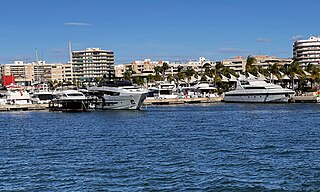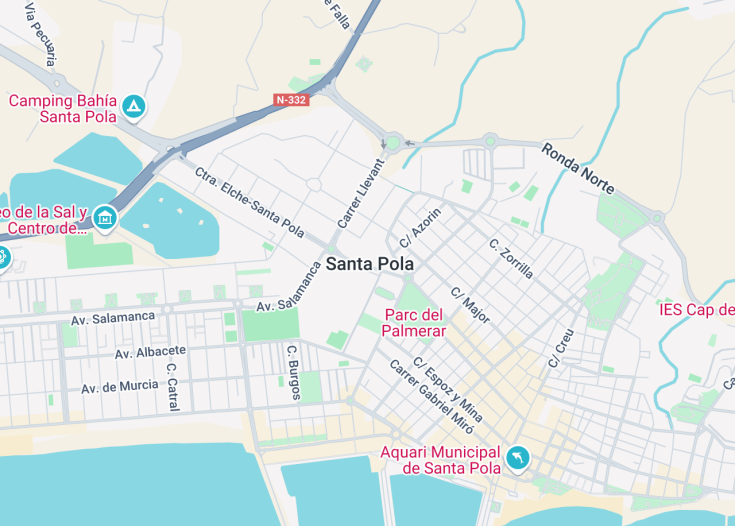Santa Pola, a picturesque coastal town in Spain’s Alicante province, is renowned for its rich history and vibrant cultural tapestry. With roots tracing back to Roman times, the town is a charming blend of ancient ruins, scenic beaches, and a bustling fishing port.
Visitors are drawn to its beautiful promenades, diverse wildlife at the Salinas, and the iconic lighthouse. Santa Pola also serves as a gateway to the idyllic Tabarca Island, offering a perfect escape with its crystal-clear waters and tranquil environment.
For an unforgettable experience, visit the Santa Pola sea museum to delve into the town’s deep maritime roots and its historic connection with the sea.
Plan your visit in early September to enjoy the vibrant festivities of the Virgen de Loreto, which capture the essence of Santa Pola’s community spirit and cultural heritage.
Santa Pola: Gateway to the Idyllic Costa Blanca
| Country | Spain |
| Time in Santa Pola | GMT+1 |
| Language spoken | Spanish |
| Population | 31,760 (source: latest census 2023) |
| Currency | Euro (€, EUR) |
| Airports |
|
Santa Pola, nestled on Spain’s southeastern coast, is a beautiful and dynamic coastal town known for its historical significance and vibrant tourism industry. At its heart lies a rich history dating back to Roman times, evident from the well-preserved Roman house, Villa Romana del Palmeral, and the Archaeological Museum that houses relics from this era. Its evolution from a small fishing village to a bustling tourist destination is captivating.
The town’s economy thrives on fishing, salt production, and tourism, particularly from Northern European visitors. Known for its picturesque landscapes, Santa Pola boasts stunning beaches such as Playa Lisa and Gran Playa, which are famed for their golden sands and crystal-clear waters. The local gastronomy offers a taste of authentic Mediterranean cuisine, with seafood being a staple in many dishes. A significant landmark is the Santa Pola lighthouse, which offers panoramic views of the Alicante coast and the Tabarca island.
Aside from its natural and gastronomic offerings, the town holds cultural significance with festivities like the Moors and Christians festival, which attracts thousands of visitors who come to enjoy historical reenactments, parades, and fireworks. The natural reserve of Las Salinas provides a sanctuary for various bird species, including flamingos, making it a popular spot for nature enthusiasts.
Santa Pola also serves as a crucial nautical sports hub with facilities and conditions ideal for windsurfing, kitesurfing, and sailing, drawing sport enthusiasts from around the world. Its proximity to Major cities like Alicante enhances its appeal as a tourist destination that combines serenity with accessibility.
Where is Santa Pola?
Santa Pola is located along the Costa Blanca in the province of Alicante, southeastern Spain.
Distances:
| Route | Distance by car | Time by car |
|---|---|---|
| Alicante to Santa Pola | 13 miles (21 km) | 25 minutes |
| Elche to Santa Pola | 12 miles (20 km) | 20 minutes |
| Valencia to Santa Pola | 110 miles (177 km) | 1 hour 50 minutes |
What is Santa Pola famous for?
Santa Pola is renowned for its beautiful beaches, historical remnants like the fortress Castillo-Fortaleza, and the picturesque island of Tabarca nearby. Its annual Moors and Christians festival dramatically showcases the town’s rich history and cultural heritage.
History
Prehistoric Times to Roman Rule
The history of Santa Pola, a picturesque coastal town in Spain, traces back to ancient times. Archaeological findings indicate the presence of prehistoric settlements in the area, inhabited by various cultures that exploited the rich marine and land resources. Transitioning into the era of antiquity, the region saw significant influence under the Romans starting around the 4th century BC, as evidenced by the remains of the Roman villa “El Palmeral” and the intricate salting factories that reveal the town’s early engagement in salt production and fish salting, a vital Roman industry.
Medieval Period – 5th to 15th Century
With the decline of the Roman Empire, Santa Pola saw a series of invasions and rulers, including the Visigoths and later, the Moors. The Moorish period, which commenced in the early 8th century, introduced advanced agricultural techniques and irrigation systems, transforming the landscape and the economy. The town was known as “Al-Hawwara” during this period. It wasn’t until the 13th century, during the Reconquista, that Santa Pola was reintegrated into Christian territories. The construction of a fortress in the 14th century marked a significant era of defense against pirate attacks.
16th Century to 19th Century
The Renaissance period heralded the construction of Santa Pola’s most notable historical structure, the Castle of Santa Pola, built in the 16th century to protect against the frequent pirate incursions. Throughout the 17-19th century, Santa Pola evolved slowly, with the economy primarily relying on fishing and salt production, which were the mainstays of the local economy.
20th Century to Present
The 20th century marked a period of significant transformation for Santa Pola, as it evolved from a quiet fishing village into a vibrant tourist destination. Post Spanish Civil War development, and especially the boom in the 1960s-70s tourism industry, reshaped its economy and infrastructure, catering to both national and international visitors. Today, Santa Pola is celebrated not only for its historical heritage but also for its bustling markets, beautiful beaches, and as a hub for water sports.
Visit Santa Pola
What to see and do in Santa Pola, Spain
Santa Pola, rich in history and natural beauty, offers a plethora of attractions and activities for visitors. Key highlights include:
- The Castle-Fortress: Explore this 16th-century fortress that now hosts historical exhibits and art shows.
- Salinas de Santa Pola Natural Park: Ideal for bird watching, especially flamingos, in their natural habitat.
- Maritime Museum: Learn about the town’s seafaring past and its relationship with the sea.
- Beaches: Enjoy the beautiful beaches like Playa Levante and Playa Varadero for relaxation or water sports.
- Pola Island: Take a short boat trip to this scenic island for snorkeling and exploring diverse marine life.
Annual Events in Santa Pola
Santa Pola hosts several cultural and festive events throughout the year. Notable among them are:
- The Moors and Christians Festival in September, celebrating the historical battles between Moors and Christians.
- Virgen del Carmen Festival in July, honoring the patron saint of fishermen with processions and maritime events.
These events highlight the rich cultural tapestry and communal spirit of Santa Pola.
Best time to visit Santa Pola
The ideal time to visit Santa Pola is between late spring and early autumn, from May to October, when the weather is warm and sunny, perfect for beach activities and exploring the outdoors.
Is Santa Pola worth visiting?
Indeed, Santa Pola is certainly worth a visit. Whether you’re a history enthusiast eager to explore ancient sites, a nature lover keen on observing wildlife in the Salinas park, or a beach aficionado looking for sunny, sandy retreats, Santa Pola offers a diverse array of attractions.
Additionally, the welcoming local festivals and the delicious seafood cuisine enrich any visit, making Santa Pola an enriching destination on the Costa Blanca.









